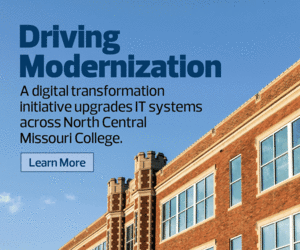Hyperconverged Infrastructure vs. the Cloud
Two key aspects are critical to understanding where HCI and cloud computing overlap and where they differ: characteristics and composition.
When it comes to functional characteristics, the cloud and hyperconverged infrastructure are remarkably similar. Both offer the ability to access computing power on demand, making it possible to scale up (or down) as necessary, and both provide inherent reliability.
The technologies diverge when it comes to composition. Whether schools use on-premises private clouds or offsite public options, cloud services leverage discrete computing, storage and network hardware solutions that are connected using a logical abstraction layer and managed using a hypervisor.
Meanwhile, HCI combines and virtualizes the entire hardware stack but keeps resources on-premises to reduce latency and increase visibility. Hyperconverged infrastructure is the logical next step in the evolution of data centers. First was traditional infrastructure, which saw discrete network, server and storage architecture. Next came converged infrastructure, which leveraged software-defined networking to help virtualize storage and network management. Now, HCI makes it possible to combine the key functions of computing, storage and networking technologies as a single IT cluster.
GET THE WHITE PAPER: Hyperconvergence is going mainstream.
How Hyperconverged Infrastructure Can Benefit Higher Ed
Making the move to HCI offers several benefits for postsecondary schools:
● Simplicity: Thanks to its node-based approach, HCI frameworks are easy to deploy and simple to manage. This sets them apart from more traditional cloud solutions, which can quickly become complex as schools expand cloud environments with new providers and services. The unified and virtualized nature of HCI makes it naturally simple to manage and expand.
● Spend Management: HCI can also improve cost control. Where cloud services can quickly sprawl, causing spending to increase exponentially, hyperconverged environments exist entirely under the auspices of university IT teams. Convergence can also help reduce the time and cost required for software upgrades and hardware replacement thanks to built-in failover capabilities.
● Scalability: HCI nodes are effectively preconfigured building blocks, making it easy for IT teams to quickly scale resources up or down, on demand and with minimal effort. It is worth noting, however, that HCI deployments have specific limits when it comes to the number of nodes added per cluster, and resources must be deployed in specific increments. On the flip side, while the cloud can scale indefinitely, this isn’t always a good thing. Given the disparate nature of public and private cloud deployments, unlimited scaling potential can lead to significantly increased complexity.
● Speed: The node-based approach of HCI also increases deployment speed, regardless of resource type. From storage to computing, networking or security, new solutions can be integrated on demand and without risk of interoperational conflict.
RELATED: How hyperconvergence simplifies data center management.
The New Normal: Embracing Data Center Modernization
For schools to succeed in a post-pandemic world, they need IT infrastructure capable of delivering both on-premises and offsite education without sacrificing speed or compromising security.
At the center of this next new normal is data center modernization — the ability to collect, curate, use and scale data-driven resources on demand to meet evolving staff and student expectations while ensuring personal and professional privacy.
Hyperconverged infrastructure forms a key pillar of this modernization approach. Along with solutions such as high-performance computing to drive research initiatives and core network upgrades to provide necessary bandwidth backbones, it’s now possible for postsecondary schools to create functional frameworks capable of staying ahead of the curve.











